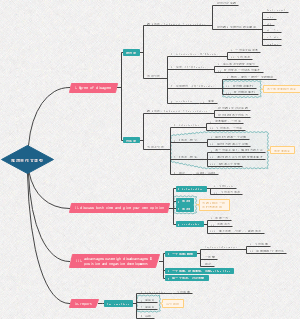导图社区 专题八:动词
- 1.0k
- 113
- 10
- 举报
专题八:动词
英语语法的知识点干货分享!下图包括了动词的基本形式 、 系动词 、 助动词 、情态动词 、 常用动词区别 等方面的知识,内容举例详细,十分的全面,快收藏学起来吧!
编辑于2020-02-21 16:32:30- 动词
- 相似推荐
- 大纲
专题八.动词
考点1 东西的基本形式
eg:
考点2 系动词
后面要接名词或形容词构成谓语。 常见的系动词有:look, smell等。 具体用法详见形容词考点2。
考点3 助动词
本身不具有实际意义,不能独立作谓语,必须和实义动词一起用,在句中帮助提问,否定以及构成相应的时态和语态。常用的助动词有:be(is, am, are, was, were, isn’t, aren’t, wasn’t, weren’t, am not), do(do, does, did, doesn’t, don’t, didn’t), will(will, won’t, would, wouldn’t), have(have, has, haven’t, hasn’t)等。
1. be作助动词时的用法:be可以放在句首(疑问句),也可以放在句中。它可以与going to一起表示将来时,也可以与动词-ing形式一起表示进行时,以及和动词过去分词一起表示被动语态。如: ①I am going to be a middle school student next year. 明年我将是一名中学生了。
2. do作助动词时的用法:实义动词变疑问句或否定句以及加强语气时,需要借助do 来表示。do可以放在句首(疑问句),也可以放在句中,它们后面接动词原形。如: ①—Do you like walking after supper? —你喜欢饭后散步吗?(构成一般疑问句) —Yes, I do. / No, I don’t. 是的(不),我(不)喜欢。(用作代动词,避免重复)
3. will作助动词时的用法:will 后接动词原形,表示将来时。will可以放在句首(疑问句),也可以放在句中。如: —Will you go shopping with me this weekend? 你这周末和我一起去购物吗? —Yes, I will. / No, I won’t. 是的,我要去。/ 不,我不会去。
4. have作助动词时的用法:have(has)后接动词过去分词,表示现在完成时。have可以放在句首(疑问句),也可以放在句中。如: ①Have you ever been to the Great Wall? 你曾经去过长城吗? ②I haven’t received his invitation. 我还没收到他的邀请。 ③He has decided to set out tomorrow, but he hasn’t decided where to go. 他已经决定明天出发,但还没决定去哪里。
考点4 情态动词
表示说话人的情感与态度,不能单独作谓语,只能和实义动词原形一起构成谓语,一般无人称和数的变化。 1. 常用的情态动词一览表:
2. 情态动词表推测:部分情态动词可以用来表示推测,推测的可能性由小到大为: can’t(不可能)→might→may(可能)→could→can(可能,用于疑问句)→must(一定是) 如:①The man under the tree can’t be John. He went to London with his parents yesterday. 树下的那个男人不可能是约翰。他昨天和父母去伦敦了。
3. 难点突破: (1)can(could)与be able to的辨析 can只用于现在时,过去时用could,此两词不用于其他时态。be able to可用于任何时态。如: ①She can (is able to) drive a car. 她能开车。 ②He could (was able to) play the piano at the age of ten. 他10岁时就能弹钢琴。 ③I will be able to ride a bike in a week. (不能用can/could) 一个星期内我就会骑自行车。 (2)must与 have to的辨析 must强调由主观因素决定。have to强调由外界条件决定。如: ①I think I must finish my work today. 我想我必须在今天之内完成我的工作。 ②The last bus has gone. I have to walk home. 最后一辆公交车开走了。我必须要走路回家了。 (3)must的否定形式 must 表示“必须”时,否定形式为needn’t或don’t have to,表示“不必”,而不是mustn’t。mustn’t表示“禁止”。如: ①They needn’t have breakfast so early. 他们不需要这么早吃早餐。 ②You mustn’t talk in class. 你不准在课堂上讲话。 (4)几个情态动词否定形式的意义: might not / may not (可能不); can’t / couldn’t (不可能); mustn’t (禁止)。如:①There are many stars in the sky. It may not rain tomorrow. 天上有很多星星。明天可能不会下雨。 ②He had a big meal just now. He can’t be hungry now. 他刚吃了一顿大餐,现在不可能饿。 ③The children mustn’t play football in the street. 孩子们禁止在街上踢足球。 (5)几个情态动词在一般疑问句中的回答: ①—May I smoke here? 我可以在这里抽烟吗? —Yes, you may. 是的,你可以。/ —No, you mustn’t / can’t / had better not. 不,你不能。 ②—Can you come to see me tomorrow? 你明天能来看我吗? —Yes, I can. 是的,我可以。/ —No, I can’t. 不,我不能。 ③—Must he go now? 他现在必须走吗? —Yes, he must. 是的,他必须走。/ —No, he needn’t (doesn’t have to). 不,他不需要。 (6)need的用法 (1)need作情态动词时,表示“需要”其否定形式为needn’t,表示“没有必要,不必”,常用语否定句和疑问句。 (2)need 还可作实义动词,常用于“need to do sth.”结构,其否定形式为助动词(否)+need to do sth. I need to learn more. 我需要学习更多知识。
考点5 常用动词区别
1. 用bring“带来←”,take“带走→”,carry“带重物”填空。
2. 用look for“寻找”(表示过程),find“找到”(表示结果)填空。
3. 用say“说话”(后有内容), speak“会说”(讲某种语言,若表示与某人讲话时要用speak to sb.), tell “说”(讲故事, 说谎等),talk“谈话”(与人谈话,常用talk with 或talk to; 谈论某事用talk about)填空。
4. 用look“看”(表示动作), see“看见,观看” (表示结果), watch“注视”(看电视,比赛等), read“阅读”(看文字类东西)填空。
5. 用wear“穿”(表示状态, 后接物), put on“穿” (表示动作, 后接物), in“穿着”(后常接颜色), dress“穿”(给某人穿戴,后接人)填空。
6. 用borrow“借入”,lend“借出”, keep“保有,不退还” (借多长时间)填空。
7. pay, cost, spend, take的区别 花时间的两种表达法:①It takes/took sb. +时间+to do sth. ②sb. spend +时间+on sth. /(in) doing sth. 花钱的三种表达法:①sth. cost sb. + 钱.②sb. pay +钱+ for sth. ③sb. spend +钱+on sth. /(in) doing sth.
8. arrive, reach, get的区别 三者都表示“到达”。后面不接地方时,只能用arrive; 后面接地方时,三个词都可以用。具体搭配如下: arrive in +大地方;arrive at +小地方;reach +地方;get to +地方。









